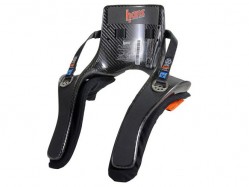|
|

In the dark ages of motorsports, relatively minor accidents were often fatal. Case in point: Patrick Jacquemart’s 1981 head-on collision into a dirt bank at Mid-Ohio while testing his Renault 5 Turbo IMSA GTU racer. Even though damage to the car was minor, Jacquemart died from a basilar skull fracture—a break in the bones at the base of the skull resulting in severe brain trauma.
Such accidents were typically chalked up to bad luck or the cost of racing, but this mishap was different. Jacquemart’s friend and fellow racer Jim Downing wondered what could be done to avoid such tragedies. In response, Downing and his brother-in-law Dr. Bob Hubbard, who earned his Ph.D. in engineering studying the mechanical properties of skull bones, invented the “head and neck support” now known and marketed as the HANS device.
The HANS essentially works like an airbag. But instead of inflating a cushion to arrest occupant motion in a collision, it uses a raised collar and two polyester-fabric tethers to secure the driver’s head. The driver’s shoulder belts hold the tall, stiff collar securely in place. The tethers link the sides of the driver’s helmet to collar anchor points. When g-loads build during a forward impact, the HANS device assures that the driver’s helmeted head moves with his torso so vulnerable neck and skull bones aren’t overloaded.
|
|
The above sled-test drawings show the HANS at work. With only a neck to restrain it, a 15-pound helmeted head lunges forward at 107 g during a 40-g head-on collision. Resulting “shear” (two opposing forces perpendicular to the neck’s axis) and “tension” (pulling force along the neck axis) loads vastly exceed the injury threshold, making death more likely.
The restraint provided by the HANS device reduces neck tension by 81 percent, shear by 72 percent, and the total neck load by 78 percent. The head experiences a tolerable 62 g. Because the driver’s head and neck motion is now in synch with his torso’s movement, chest g-forces rise slightly, though chest compression is reduced.
Downing wore a HANS prototype in a 1986 race. Three years later, Wayne State University, in Detroit, Michigan, tested the device on a crash sled, the first such test of any racing-safety equipment in America, according to Hubbard. Sales began in 1991, after which GM, Ford, and Mercedes-Benz pitched in with development support. CART made the device mandatory in 2000.
Unfortunately, it was only after a sensational tragedy that HANS gained wide acceptance. Hubbard recalls that throughout the 1990s, only 250 or so units were sold. But following Dale Earnhardt’s death in the 2001 Daytona 500, 250 HANS devices were sold in one week. Today, most race-sanctioning organizations require drivers to wear these lifesavers, and more than 140,000 have been sold worldwide.
Nowadays, thankfully, motorsports safety is taken seriously. No driver with a brain worth protecting would consider racing without a HANS device.



